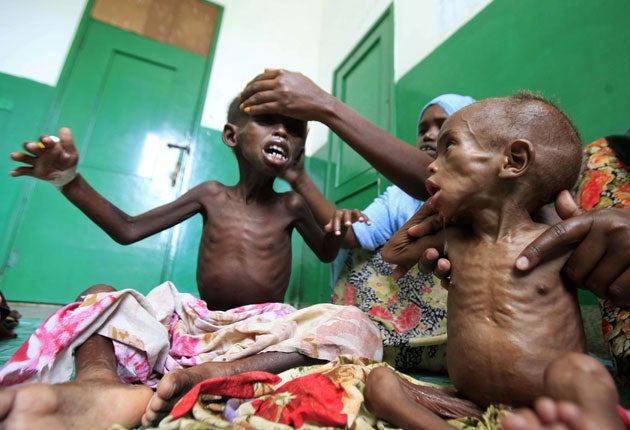Supercrops: Britain pledges large-scale funding to boost health of undernourished people in Africa
The Government is giving £30 million to HarvestPlus - an international research programme which creates nutrient-rich crops

Your support helps us to tell the story
From reproductive rights to climate change to Big Tech, The Independent is on the ground when the story is developing. Whether it's investigating the financials of Elon Musk's pro-Trump PAC or producing our latest documentary, 'The A Word', which shines a light on the American women fighting for reproductive rights, we know how important it is to parse out the facts from the messaging.
At such a critical moment in US history, we need reporters on the ground. Your donation allows us to keep sending journalists to speak to both sides of the story.
The Independent is trusted by Americans across the entire political spectrum. And unlike many other quality news outlets, we choose not to lock Americans out of our reporting and analysis with paywalls. We believe quality journalism should be available to everyone, paid for by those who can afford it.
Your support makes all the difference.Britain is to spend tens of millions introducing ‘supercrops’ to boost the health of millions of undernourished people in Africa and Asia, in a controversial move that campaigners have branded a “techno-fix” which ignores the root causes of food poverty.
The Government is giving £30 million to HarvestPlus - an international research programme which creates nutrient-rich crops - to develop and deliver vitamin and mineral enriched varieties of cassava, maize, beans, millet, rice and wheat to millions of farmers and their families.
The funding is part of an extra £375m in ‘core funding’ the Government has set aside to tackle world hunger between now and 2020 – during which time it aims to save the lives of 1.7 million children and drive down rates of malnutrition.
Hundreds of millions of people worldwide do not get enough nutrients such as vitamin A, zinc and iron, in their diets. This can lead to lower IQ, stunting, and blindness in children; increased susceptibility to disease, and higher health risks to mothers, and their infants, during childbirth.
And the investment in supercrops reflects the Government’s intention of ‘doing development differently’. Speaking at an international “nutrition summit” in London recently Prime Minister David Cameron described how the role of science is “about harnessing the power of innovation to develop better seeds and more nutritious and productive crops.”
The six new varieties of staple crops will be distributed to 3.8m farmers and their families by 2015. They have been created through selective breeding of strains with naturally higher levels of certain vitamins and minerals. The crops include vitamin A-rich cassava and maize, and iron-rich beans – targeted at the Democratic Republic of the Congo, Nigeria, Rwanda and Zambia. And iron-rich pearl millet and zinc-rich wheat and rice are aimed at India, Pakistan and Bangladesh. The nutrient-loaded crops will contain between 30 and 50 per cent of the average daily requirement for vitamin A, zinc and iron.
International Development Secretary Justine Greening said: “In much of the developing world it is not just a lack of food that can cause disease and suffering, but also a lack of vitamins and nutrients. Malnutrition is the world’s biggest underlying cause of child deaths and is holding back economic growth across the globe.”
She added: “These superfoods are a fantastic way to get vital nutrients into meals that the world’s most vulnerable people eat every day without them changing their eating habits.”
The new approach is a radical departure from the traditional way of dealing with undernourished people by doling out vitamin and mineral pills or fortified foods.
But last night the World Development Movement (WDM) dubbed the move a “techno-fix” which would “do nothing to address the root causes of poverty and inequality, which are political.” WDM spokeswoman Miriam Ross added: “David Cameron would have us believe that business and science are the answers to global hunger, but this ignores the implications of unpayable debt, unfair global trade rules and the increasing concentration of power in the hands of corporations at the expense of the poor.”
And Vicki Hird, senior food campaigner, Friends of the Earth, cautioned: “Enhancing staple crops could help if farmers can afford them and can save the seeds. But sorting out food security will require far more - such as tackling our overconsumption, ending biofuel targets and supporting small scale, farmer-led initiatives.”
The new supercrops
Yellow cassava – Democratic Republic of the Congo, Nigeria
Normally white, the flesh of the cassava plant is now yellow - a consequence of a massive boost in vitamin A. Provides 50 per cent of the daily requirement.
Orange corn (maize) - Zambia
More than half of children suffer from vitamin A deficiency. The new variety of maize provides half [50 per cent] of the daily requirement.
Iron beans - Rwanda
In Rwanda, where beans are a lunchtime staple, more than a third of children suffer from anaemia due to a lack of iron in their diet. The new crop provides 30 per cent of the daily iron requirement.
Iron millet - India
More than 50 million people in India eat pearl millet every day. The new variety provides 30 per cent of the daily iron requirement.
Zinc rice – India & Bangladesh
The majority of poor people in Asia, where rice is the staple food, suffer from zinc deficiency. The rice provides 40 per cent of the daily requirement.
Zinc wheat – India & Pakistan
Wheat is the second most consumed cereal in Asia. The new crop provides 40 per cent of the daily zinc requirement.
Join our commenting forum
Join thought-provoking conversations, follow other Independent readers and see their replies
Comments